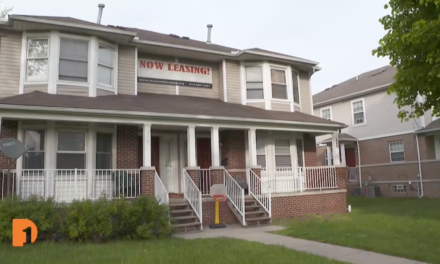In a special Election 2020 report, Christy takes a closer look at the changing makeup of voters in Oakland County and their possible impact on the 2020 presidential election.
Read full transcript
Narrator Oakland County was a Republican stronghold in presidential elections up until the mid-90s when the county flipped voting for Bill Clinton in 1996 and continued voting for Democratic presidents in the next five elections.
Narrator Before we get into how this county started trending blue and what that could mean for the 2020 election, let’s understand the folks who call Oakland County home.
Narrator For the figures, We searched this census, found data from Oakland County, and returned to metro Detroit stats guru Kurt Metzger. Oakland County is wealthy and well-educated. The median income in Oakland County is eighty thousand dollars. That’s twenty-three thousand dollars more than a typical Michigan household. The county has a large manufacturing and technology base, making it a landing spot for the well-educated.
Kurt Metzger Oakland County has always been higher educated. Just over 47 percent of the population has at least a bachelor’s degree. That’s a population 25 and over, and Macomb County is only 25 percent.
Narrator Oakland County continues to grow in diversity.
Kurt Metzger Oakland County has also benefited from immigration as well. But Oakland County tends to get more educated, higher income. Oakland County has a very large Asian population, primarily Asian, Indian and Pakistani, Chinese, Japanese, but a much higher income population as well.
Narrator From 2010 to 2018, the Asian population has grown 45 percent. They live in communities like Troy and Rochester Hills, Novi and South Lyon.
Kurt Metzger But the strength of the technology sector in Oakland County really has attracted a large Asian population.
Narrator About 14 percent of the population is African-American.
Kurt Metzger Over the years, you had the Jewish population in Detroit moving into Oakland County and then moving to the northwest and then African-Americans kind of following that same pattern.
Narrator One unique majority African-American community in Oakland County is Lathrup Village.
Kurt Metzger What I’ve found interesting is its city majority African-American with a median income higher than the national average of one hundred and thirty of those communities across the country. Lathrup Village is the only one in Michigan.
Narrator Diversity dwindles as you head to the northern end of Oakland County.
Kurt Metzger It starts to get pretty quiet when you start to get to Clarkston and Davison and Lake Orion those areas, upscale white population but tends to be in many ways kind of a population that has separated itself from Detroit.
Narrator Head back down to the Woodward corridor and you find many young people.
Kurt Metzger But a lot of small communities with downtowns, you’re seeing tremendous resurgence.
Kurt Metzger When you look at communities like Ferndale and Royal Oak, and Clawson, and Berkeley, all these are seeing tremendous growth. Lot of building going on.
Narrator But despite the resurgence. Oakland County is bracing for an aging population.
Kurt Metzger We’re projecting in 2025 there will more people 65 and over in Oakland County, than 18 and under. And they’ll be … that’ll be the first county to do that. Nationally, it’s supposed to happen 10 years later.
Narrator OK, so those are the numbers on education, diversity and age. In a moment, you’ll hear how each play a part in the changing political landscape of Oakland County. So let’s recall what happened in the midterm elections. Voter turnout was high. Sixty-five percent of voters cast ballots. Oakland County saw a powerful blue wave.
Narrator Voters helped flip formerly Republican-held congressional seats, choosing Democrats Elissa Slotkin and Haley Stevens and helped elect a Democratic governor Gretchen Whitmer. Republicans lost power countywide for the first time in decades.
Narrator Democrats won the offices of prosecutor, treasurer, clerk, water resources commissioner and gained a majority on the County Board of Commissioners. After L. Brooks Patterson passed away last year, democrat David Coulter was appointed county executive. Patterson had held the office since 1992. Michigan pollster Ed Sarpolus argues one reason behind the blue wave is the second generation of immigrants who now vote.
Ed Sarpolus You see that multiculturalism because now those people of color and cultures are now voting. Their parents they never learn a English language or may not have voted, but now their children who have now been here and educated they’re now voting. That’s the big difference.
Narrator Another key voting bloc, suburban women.
Ed Sarpolus What’s changing is now you have all these college-educated women, young and old. They’re concerned about their careers and discern about their kids. Now you’re having a blend of women who are conservative on some issues, but they haven’t lost their moderate views on social issues.
Narrator Democratic pollster Stan Greenberg spoke with college-educated women in Oakland County. What he found surprised him.
Stan Greenberg The suburban women, you know, sounded like base Democrats and they were upset about the racism. They were upset about the anti-immigrant sentiment and the encouragement of it, you know, racist and violent behavior that was taking place in the country. They are upset with what was happening with guns. All of which they think the president was was encouraging. The suburban rebellion against Trump is … is pretty profound, that it’s, I’m in awe of it. There’s a women’s tsunami coming. That’s playing out across every segment. It’s strongest among the college-educated suburban women. You know, they’re leading it in a very conscious of the fact that they’re leaning it going forward into two thousand twenty. And that would change everything.









